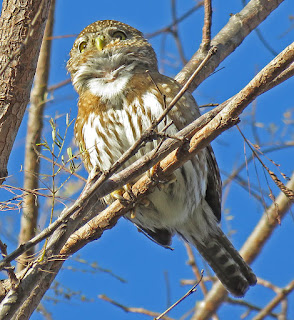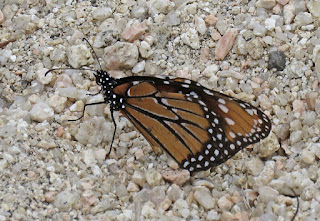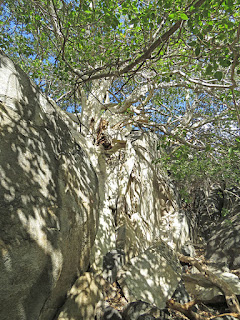On the
second day of my WINGS tour to the Cape Region of Baja California Sur we headed
towards the Sierra La Laguna Biosphere Reserve in the core of the peninsula.
There is only one bumpy, washboarded road that leads 23 kilometers from the
main highway to an elevation of about
700 meters (2300 feet) in a collection of private ranches known as San Antonio
de la Sierra. It’s not that high, but the slightly cooler temperatures and
higher rainfall support an open oak woodland and a fascinating mix of vegetation
along the arroyos that differs strongly from the tropical thornscrub and desert
from the more accessible areas of the peninsula. Brahea brandegeei, Brandegee's Fan Palm, is one of the most
beautiful members of this plant community, which also includes several endemic
oaks, an endemic cottonwood, and many others. This palm isn’t endemic, also occurring
across the gulf in Sonora. In fact, the northernmost records are only about 50
miles (80 km) south of Douglas, Arizona in the same watershed as Guadalupe Canyon.
Another non-endemic
is Acacia farnesiana, Sweet-ball
Acacia, also known as Huisache in Texas. The plants here were in full bloom and
particularly fragrant, the enchanting smell filling the air as we walked near them.
Somewhere
between 1/4 and 1/3 of all the plants are endemic to the peninsula, including nearly
30 species of nipple cactus. This looks closest to the endemic Mammillaria schumannii, but the field
guide only includes eight species in the genus, and flowers are needed for
certain ID.
Despite not
having a tall, dense evergreen forest, this elevation is apparently offers
perfectly good habitat for the endemic subspecies of Northern Pygmy-Owl, which
when split will be called Cape Pygmy-Owl (with slightly higher, shorter, and
downslurred notes, as well as slightly faster delivery than most birds from
California and Oregon). We had two of them, and I’ve never missed it in my six
trips here. They are only rarely found away from this oak woodland in the
mesquite and acacia-dominated woodland at lower elevations in well-watered
arroyos.
The endemic
Xantus's Hummingbird also prefers woodland over open desert scrub, but it’s not
picky as to the plant species and can be found down to sea level as long as
there is food and cover. This is a very reliable place for them, and we watched
this male feeding repeatedly from the developing inflorescences of the
Brandegee’s Fan Palms, presumably a sweet exudate on the buds. It would rest
between feeding bouts on shrubs just a few feet away from us below eye level.
This area is
crawling with passerines that breed in the Pacific Northwest. This is Pacific-slope
Flycatcher.
I was amazed
and delighted to see the orange on this Orange-crowned Warbler through my
camera’s viewfinder as I snapped this shot.
There were
several Western Tanagers here and many other places where we birded.
Ash-throated
Flycatcher is very common in all habitats in the peninsula, largely feeding on
fruits of Bursera species.
This
Red-tailed Hawk is probably a resident bird, looking very much like the pale
subspecies Buteo jamaicensis fuertesi from
Arizona. A lot of the immature and darker adult birds we saw were probably
wintering here from the US or Canada. A bird fitted with a satellite
transmitter in the Goshute Mountains, Nevada in 1999 wintered not far north of
here three years in a row, returning to a summer territory in Idaho each year.
We did not
see nearly as many butterflies as I have in previous years, but it began to get
cloudy before noon, keeping it pleasantly cool for us. This is Danaus gilippus, the Queen.
Anthanassa texana, Texan Crescent. Both
of these are also common in my yard in Tucson.
On the way
back to our hotel in the afternoon we stopped in San Bartolo to admire a grove
of these amazing Ficus palmeri,
Desert Rock Figs. They were full of fruit, attracting probably over 20 Western
Tanagers.


















No comments:
Post a Comment